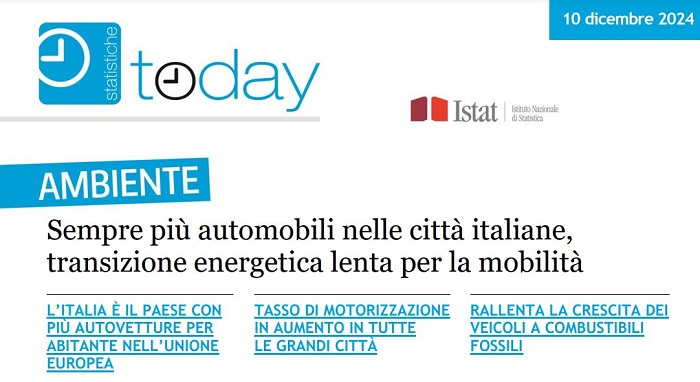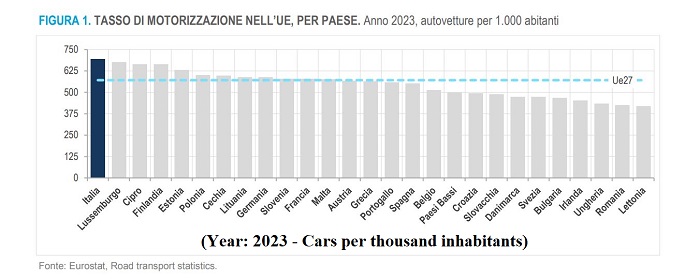In Italy 694 cars per 1,000 inhabitants: it’s the most “motorized” country in Europe
ROME – Italy has always been a country of motorists: after all, it’s Ferrari’s and Lamborghini’s home. But today it is more so than ever: in 2023, in fact, the Bel Paese recorded the highest motorisation rate in the European Union, with 694 registered cars per 1,000 inhabitants against an EU average of 571.
That’s what emerges from an Istat (Istituto Nazionale di Statistica / National Institute of Statistics) new report, based on data from the Public Motor Vehicle Registry (ACI Italia) and published today: according to it, this indicator – compared to the other major economies of the Union – in Italy presents not only significantly higher values, but also a more sustained growth in recent years (by 1, 3% per year since 2018, compared to 0.7% in Germany, 0.4% in Spain and 0.3% in France).
The number of fossil fuel vehicles per capita (in the UN climate change indicator set) continues to increase nationally (from 0.873 in 2022 to 0.878), but is almost at a standstill in cities (from 0.822 to 0.823 in the 2022 indicator set for the capital municipalities), thanks above all to the spread of hybrid vehicles from 2020 onwards. However, the transition is proceeding slowly: hybrid cars are 6.9% of the total in the capital municipalities (more than 10% only in Varese, Milan and Bologna) and electric cars are just 0.6% (more than 1% only in Milan, Bergamo, Brescia, Bolzano/Bozen and Trento). The most numerous are still petrol cars (47.4%, down 0.8 points per year since 2015). The decline is even slower for diesel cars (35.2%, -0.3 points per year since 2015).
In general, among the capital municipalities the values of the motorization rate are between the minimum of Venice (457 cars/1,000 inhabitants) and the maximum of Frosinone (841). At the upper end of the range, with more than 800 cars/1,000 inhabitants, are placed, together with Frosinone, L’Aquila, Isernia, Potenza, Vibo Valentia, Agrigento, Catania and Nuoro. At the lower end, with less than 600 cars/1,000 inhabitants, we find, with Venice, Genoa, La Spezia, Milan, Trieste, Bologna, Florence, Bari and Barletta. All the capital municipalities, except Aosta and Gorizia, present higher values compared to the previous year: the most significant increases (over +3%) are found in Turin, Cuneo, Bolzano/Bozen, Pistoia and Salerno.
The data were released during the event “Road accidents: data and policy measures. A territorial framework”, which took place in Rome today. “According to the World Health Organization, in the last year 1 million 190 thousand people died due to road accidents, around 3,260 every day and almost 50 million people suffered injuries or permanent disabilities – said the president of Istat, Francesco Maria Chelli – . Road accidents are the main cause of death for young people between the ages of 5 and 29. More than half of those who have lost their lives are pedestrians, cyclists and motorcyclists. In Italy in recent years, road safety has indeed seen progress, but there is still a lot to do – explained Chelli -: if in fact in the long term there is a trend towards a decline in accidents and victims, the data published a month ago and referring to the first half of 2024, they report a new albeit modest increase: accidents increased by 0.9% and victims by 4%; if we then consider urban roads, victims have increased by as much as 8% compared to the same period in 2023. In the city, with congested and uncontrolled traffic and poor maintenance of the road surface, the risks for cyclists and pedestrians increase”. And then he added: “Training is the only true long-term answer to problems: training, starting from young people”.
To download and/or read the whole report by Istat (only in Italian), click here: Statistica-today-parco-veicolare-DEF
(the graphics and the pic above are from the same report: we added an English subtitle to the graphics)





